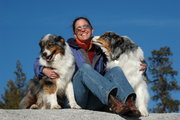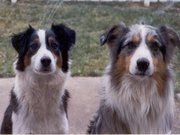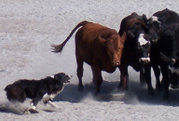|
Dog breeds of the world, Austalian Shepherd |
Australian Shepherd |
||
|---|---|---|
| Alternative names | ||
| Country of origin | ||
| United States | ||
| Common nicknames | ||
| Aussie | ||
| Classification and breed standards | ||
| FCI: | Group 1 Section 1 #342 | |
| AKC: | Herding | |
| ANKC: | Group 5 - (Working Dogs) | |
| CKC: | Group 7 - (Herding Dogs) | |
| KC (UK): | Pastoral | |
| NZKC: | Working | |
| UKC: | Herding Dog Breeds | |
| Not recognized by any major kennel club | ||
| This breed of Dog is extinct | ||
| Notes | ||
The Australian Shepherd is a working Dog that was developed—despite its name—in the United States in the 19th century. The Dog, commonly known as an Aussie, is popular in its native California and is growing in popularity in countries across the world.
Like many working breeds, the Aussie has considerable energy and drive and usually needs a job to do. It often excels at Dog sports such as frisbee and Dog agility.
The coat comes in several colors—blue merle, red merle, solid red, or solid black; all can occur with or without white markings, tan (copper) points, or both. Dogs with tan and white along with the primary color are usually called tricolor.
The breed's general appearance also varies greatly depending on the particular line's emphasis. As with many working breeds that are also shown in the ring, there are differences of opinion among breeders over what makes an ideal Australian Shepherd.
Reflecting the great variation that still exists in the breed, an Aussie can stand between 18 and 23 inches (46 to 58 cm) at the withers and weigh between 35 and 70 pounds (16 to 32 kg). For show Dogs, females should fall in the lower heights and males in the higher ranges.
A hallmark of the breed is a short bobbed or docked tail in countries where docking is permitted. Some Aussies are born with naturally short bobbed tails, others with full long tails, and others with natural partial bobs, where the tail is midlength and appears stubby. Most breeders dock the tails when the puppies are born.
Because of the Dog's origins, this breed is not for everyone. It is an energetic Dog that requires exercise and needs a job to do, whether it is learning and practicing tricks, competing in Dog agility, or any other physically and mentally involving activity. It needs to run, full out, regularly. It is usually a sweet and affectionate Dog who is faithful to its owners and is good with children, although its overwhelming instinct to work may subvert its ability to function as a family Dog, including chasing and nipping at running children to herd them if not properly trained. Its protective instinct and behaviors can be frightening to children, strangers, and small animals. It was bred to guard stock and can be sometimes annoying with its inclination to bark warnings about neighborhood activity, but it is not generally an obsessively barking Dog. It is intelligent, learns quickly, and loves to play. This means that a bored, neglected, unexercised Aussie will invent its own games, activities, and jobs, which to a busy owner might appear to be hyperactivity in the house around fragile furnishings or involve the destruction of yard and property.
 Aussies can be friendly and affectionate.
Aussies can be friendly and affectionate.
The Australian Shepherd's history is vague, as is the origin of its misleading name. Most of the breed's antecedents most likely originated in the Basque region near the Pyrenees Mountains between Spain and France.
Early European settlers took many of their herding Dogs with them as they emigrated to the eastern United States in the 19th century. Breeds included some that are now extinct or that have merged into other breeds. These probably included the English Shepherd, Dorset Blue Shag, Cumberland SheepDog, Scottish Collie, Glenwherry Collie, and Bouvier des Flandres, as well as Dogs from Germany and Spain. For many centuries, shepherds had more interest in Dogs who performed well when helping to manage flocks of sheep than they had in the specific appearance of the Dogs. As a result, over time, shepherds interbred Dogs that they believed would produce better workers for the given climate and landscape. Terrain and weather conditions in the eastern U.S. were similar to that of Europe, however, so the existing imported breeds and their offspring worked well there.
In the western states, conditions were quite different. In the primarily arid and semiarid areas inhabited sparsely by early Spanish settlers, temperatures reached extremes of hot and cold, and fields varied in altitude from sea level into the higher, rougher Sierra Nevada and similar mountain ranges. A few Spanish and Basque shepherds, their flocks, and their herding Dogs came to California with the Spanish missionaries and other settlers in the 18th and early 19th centuries.
 Black tricolor and blue merle tricolor Aussies.
Black tricolor and blue merle tricolor Aussies.
With the 1849 California gold rush, a massive migration occurred from the east coast to the west coast, and along with the people came flocks of sheep and the eastern herding Dogs. But it was just as effective to bring sheep in by ship, and in they came, including flocks from Latin America and other regions. Shepherds came along with the flocks and also independently, from Latin America, Europe, and Australia, along with their own herding breeds.
Dogs from Australia had already begun to be selected and bred for climates and terrains that were often similar to California.
As shepherds worked to develop Dogs who could handle stock in harsh storms, high arid heat, and chilling cold, and who could think on their own in challenging terrain, reacting instantly to the movement of sheep and to their handlers' commands, the type that became the Australian Shepherd was born.
The name remains somewhat of a mystery, however; the largest influx of shepherds from Australia arrived in the early 20th century, well after the breed had been established as a distinct type. It is possible that many of the imported Australian herding Dogs had merle coloring, which was also common in the American Australian Shepherd breed, and so all merle herding Dogs were simply referred to as Australian. This remains conjecture.
 Black and white (bicolor) Australian Shepherd stopping cows
Black and white (bicolor) Australian Shepherd stopping cows
Selective breeding for many generations focused on aspects of the Dog that enabled it to function as an effective stockDog in the American west. It had to handle severe weather; have plenty of speed, athleticism, energy, and endurance; and be intelligent, flexible, and independent while remaining obedient. The Australian Shepherd remained more of a type than a breed until the 1950s, when they became popular as performing Dogs in rodeos. Their stunts and skills earned them places in several Disney films, including Run Appaloosa Run and Stub: The Greatest CowDog in the West.
The Australian Shepherd Club of America (ASCA) was founded in 1957 to promote the breed, and the National Stock Dog Registry became its official breed registry the same year, which it continued until ASCA took over in the 1970s. In the late 1970s, ASCA created a breed standard, which described exactly how a Dog should look and be constructed (its conformation). This was the first step in becoming a breed rather than a type.
In the United States, the AKC is the primary breed registry for purebred Dogs. However, many Aussie breeders felt that AKC put too much emphasis on conformation and not enough on performance, so ASCA declined to join the AKC. Those breeders who felt that AKC membership had its advantages split off from ASCA to form their own Australian Shepherd club, the United States Australian Shepherd Association, created their own breed standard, and joined the AKC in 1993. The decision about affiliation with the AKC remains controversial, as it does with many performance breeds.
These Dogs excel at many Dog sports, especially herding, Dog agility, frisbee, and flyball.
There are several health problems that an Australian shepherd can have. Vision problems are common. Epilepsy is also a concern. In merle to merle breeding, the puppies who have inherited two copies of the merle gene have an increased risk of being born blind, and/or deaf.
Results of a 1998 internet survey with a sample size of 614 Australian shepherds indicated a median longevity of about 12.5 years, but that longevity may be declining. A 2004 UK survey found a much shorter median longevity of 9 years, but their sample size was low (22 deceased dogs).
The median life spans for breeds similar in size to Australian shepherds are mostly between 11 and 13 years, so, assuming the results of the UK study are not representative of the population there, Aussies appear to have a typical life span for a breed their size. Leading causes of death in the UK survey were cancer (32%), "combinations" (18%), and old age (14%).
Based on a sample of 48 still-living dogs, the most common health issues noted by owners were eye problems (red eye, epiphora, conjunctivitis, and cataracts). Dermatological and respiratory problems also ranked high.
Collie eye anomaly (CEA) is rare in the breed, but it and cataracts are a concern in Aussies. Other conditions to note include iris coloboma, canine hip dysplasia (CHD), Pelger-Huet anomaly, hypothyroidism, and nasal solar dermatitis. Prior to breeding, the Aussie should be checked for Hip and Elbow Dysphasia, DNA tests performed to show the dog to be free of the MDR1 mutation, cataract mutation, and CEA. Tests should also include those for thyroidism and clearances for other known eye diseases like colobomas, PRA and retinal folds.
Some Australian shepherds (as well as collies, German shepherds and many other herding dogs) are susceptible to a genetic mutation of the MDR1 gene. Dogs with the mutation can suffer toxicity from anti-parasitic such as Ivermectin in high doses, and other drugs. A test is available to determine if a particular dog carries the mutated gene.
Double merling or homozygous merle occurs when the resulting offspring of two merled parents inherit two copies of the dominant merle gene. The odds of this are 25% for each pup born from such a litter. Double merles often have excessive white and can have hearing and vision problems as a result of having two copies of the merle gene. Homozygous merles can be deaf, blind, express iris colobomas and microphthalmia. Not all homozygous merles are affected, but most are, making the breeding of two merles a very touchy subject. Breeders will either euthanize mostly white pups or, sometimes, sell them as "rare" white Aussies without disclosing the potential for health defects. A large percentage of homozygous merles sold eventually end up in rescue and shelters as the average family is ill prepared to take on a deaf and/or blind pet. However, deaf and/or blind Australian shepherds can make wonderful pets given a home prepared for their special needs. They are an intelligent breed, who generally learn hand signals with ease. The term "lethal white" originated from horses born with "Lethal white syndrome," and has since evolved to often describe dogs born with the double merle trait. This trait is found in many breeds, but most commonly found in Australian Shepherds. The name "lethal white" is a misnomer as this genetic condition is not lethal to the dogs, it is often the breeder who is lethal to the pup(s) by culling them immediately after birth. Many consider the term "lethal white" to be derogatory, while others are fond of it.
Many diagnostic tests are available for concerned Aussie owners to check the overall health of an Aussie. Also, the Orthopedic Foundation for Animals (OFA) has an extensive database to track results and provide statistics for the following concerns: hips, elbows, heart, patellar luxation (knees), and thyroid (autoimmune) disease. The OFA database also includes the results for eye exams performed by a Canine Eye Registration Foundation (CERF) veterinarian, but only if the owner of the Aussie submits the results. This database is a great resource to investigate the lineage and related health of the progenitors of some dogs, at least regarding hip ratings.
Many tests have been developed by, or are processed at, laboratories to check for the 11 health concerns that plague the Australian shepherd breed. Some of those labs are Optigen, Animal Health Trust, Endocrine Diagnostic Center, Animal Health Laboratory, Washington State University Veterinary Clinic, Vet DNA Center, and HealthGene. These labs might perform one or many of the tests that have been developed.
Tests or evaluations have been developed for:
Other areas that are currently not health concerns, but tests have been developed for, are:
DNA testing to either certify parentage (CP) or to verify parentage (VP) for Australian shepherds is also another test that can be performed and as of January 2010 all adults producing a litter will be required to be DNA tested to allow a breeder to register a litter with the Australian Shepherd Club of America (ASCA).
There is a list of costs, labs, applications, and samples required for the above tests at Pure Stock Aussies